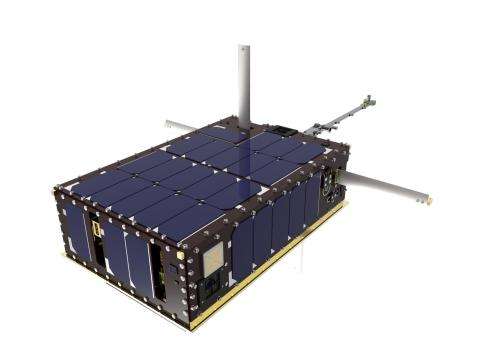NASA Skunkworks team set to deliver newfangled 6U Cubesat

(Phys.org) —A NASA "skunkworks" team gave itself just one year to develop, test and integrate a newfangled CubeSat that could reliably and easily accommodate agency-class science investigations and technology demonstrations at a lower cost.
The team, comprised of engineers and scientists at NASA's Goddard Space Flight Center in Greenbelt, Maryland, is on track to meet its self-imposed deadline.
Led jointly by Michael Johnson, the chief technologist of Goddard's Applied Engineering and Technology Directorate, and Michael Hesse, director of Goddard's Heliophysics Science Division, the team is expected to begin environmental testing of a six-unit, or 6U, CubeSat in late December. Once the team completes thermal vacuum testing, it will deliver the new CubeSat to NASA's Kennedy Space Center, Florida, where it then will be readied for launch to the International Space Station for deployment perhaps as early as January 2016.
"Rapid advances in the performance and efficiency of miniaturized systems are enabling a future only limited by vision and imagination," Johnson said. "CubeSats are a part of that future."
The CubeSat—known as Dellingr, a name derived from the god of the dawn in Norse mythology—will carry three heliophysics-related payloads. It doubles the payload capability of the ubiquitous and proven three-unit, or 3U, CubeSat pioneered by the California Polytechnic Institute in 1999 primarily for the university community.
Acute Need
The need for such a platform, which measures about 12 inches long, nearly 8 inches wide and 4 inches high, is acute, Johnson said. "We need a potentially disruptive technology that gives us a way to dramatically change the way we do science," he said. Because NASA science budgets are flat and not likely to increase in the near term, "we need more cost-effective approaches to achieve compelling Earth and space science. A 6U capability provides one way to accomplish the goal," Johnson explained.
In February 2014, Johnson and Hesse pulled together a small team of Goddard engineers and scientists to develop and implement "lean," end-to-end techniques, processes and systems for a 6U CubeSat capable of carrying out formidable scientific missions. As part of its charter, the Dellingr team was to design, test and deliver a flight-ready, fully integrated 6U CubeSat by February 2015, at a fraction of the cost of more traditional satellite missions.
The fully integrated Dellingr may be able to hitch a ride on a resupply craft headed for the International Space Station in January 2016, where it would be deployed in a high-inclination orbit similar to the station's orbital path. Its mission is expected to last up to six months.
Once successfully demonstrated, the team says it will make the platform's design—implemented with low-cost, commercial off-the-shelf parts—available to any U.S. organization interested in using it.
The Need for New and Improved CubeSat
Once the domain of university researchers, CubeSats in recent years have increasingly become more popular among government researchers. Motivated in large by their growing capabilities and relatively inexpensive cost, NASA and other government agencies are increasing their investments in CubeSats. NASA now is funding CubeSat mission opportunities through various programs.
In addition to their low cost, CubeSats enable mission configurations not possible with more traditional approaches. Instead of launching just one satellite, mission planners could deploy swarms or constellations of these tiny platforms to execute simultaneous, multi-point observations.
Technologists, meanwhile, also are interested in using CubeSats. Before mission planners can infuse a prototype technology, its developers must first demonstrate the technology in a relevant end-to-end space environment. CubeSats have the potential to offer the needed access at greatly reduced costs, Johnson said.
However, 3U CubeSats, while adequate, "don't always offer our scientists the payload volume they require for their missions," he added.
Disadvantages of the 3U size include more constraints on volume and power, said Chuck Clagett, Dellingr project manager. Furthermore, some studies suggest that previous CubeSats failed 40 percent of the time. By doubling the platform's girth, increasing its power capacity, and employing novel processes to increase its on-orbit reliability, the team believes it will have created a platform capable of carrying out more robust missions for science. "Our goal is to create a platform that is successful more than 90 percent of the time—similar, in fact, to sounding rocket flights," Clagett added.
Heliophysics Payloads
Three heliophysics-related payloads will make the maiden journey. One, the miniaturized ion/neutral mass spectrometer, actually will be tested for the first time aboard the National Science Foundation's ExoCube mission, which will measure the densities of all significant neutral and ionized atom species in the ionosphere, the outer region of the atmosphere where incoming solar radiation ionizes a large fraction of atoms. ExoCube is launching in January 2015 as part of the CubeSat Launch Initiative on the ELaNa X mission. Two magnetometer systems will be demonstrated, as well. NASA's CubeSat Launch initiative provides opportunities for small satellite payloads to fly on rockets planned for upcoming launches or deployments from the International Space Station. It is open to NASA centers, U.S. not-for-profit organizations and accredited U.S. educational organizations.
"Dellingr is an innovative, fast-track mission that demonstrates our ability to execute reliable, small science-grade missions inexpensively and rapidly," said Luis Santos Soto, Dellingr deputy project manager and engineer at NASA's Wallops Flight Facility in Virginia who has spent the past five years working on CubeSats and developing mechanisms specifically for these tiny craft. "For us, this is a pathfinder. It symbolizes the dawn of a new age for CubeSats at Goddard."
Provided by NASA




















